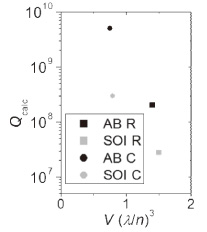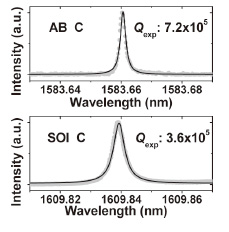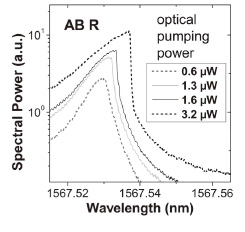Hideaki Taniyama, and Masaya Notomi
Optical Science Laboratory
It is well known that a suitably designed chain of submicron holes in
a silicon submincron wire-like waveguide fabricated on a silicon-on-insulator
(SOI) substrate acts as a nanocavity. It belongs to one-dimensional (1D)
photonic crystal (PhC) nanocavities and has attracted attention because
it has the simplest design and smallest footprint. However, compared to
two-dimensional (2D) PhC nanocavities, which have been highly developed
and widely used, the 1D nanocavity have a relatively poor quality factor
(Q ). In this study, applying the mode-gap confinement approach, which had achieved great success in 2D nanocavities, we found solutions for realizing an ultrahigh Q value in a 1D nanocavity [1].
We studied 1D nanocavities consisting of rectangular (R) and circular holes (C). The buried oxide (BOX) layer underneath the nanocavity was removed in an air-bridge structure (AB) and preserved in a SOI structure. The size of the holes was continuously modulated to generate a mode-gap barrier. Electro-magnetic simulations using the 3D finite-domain time-difference (FDTD) method demonstrated that both structures held ultrahigh Q values exceeding 108 and that the C nanocavities had a modal volume (V) smaller than 1(λ/n)3 (Fig. 1) [1, 2]. Note that even in a SOI structure, our design allows
an ultrahigh Q of 〜108, which is a unique feature of the 1D nanocavity. These numerical predictions were experimentally demonstrated by measured Q of 3.6×105 in the SOI C and 7.2×105 in AB C nanocavities (Fig. 2) [2].
Since air acts as thermal insulator, a 1D AB nanocavity has a considerably
large heat resistance, which was demonstrated by numerical simulation.
In such a nanocavity, thermo-optic nonliniearity is enhanced greatly. We
observed the lowest thermo-optic bistabilty onset power of 1.6 µW
in a AB R nanocavity (Fig. 3) which had a high optical Q of 2.2×105[3]. Considering the great structural difference between the 1D and the
2D nanocavities, we can expect unique advantages and applications of the
former.
This work was partly supported by CREST of Japan Science and Technology
Agency.
[1] M. Notomi et al., Opt. Express 16 11095 (2008).
[2] E. Kuramochi et al., Opt. Express 18 15859 (2010).
[3] L. D. Haret et al., Opt. Express 17 21108 (2009).
 |
 |
 |
||||||||
|
|
|